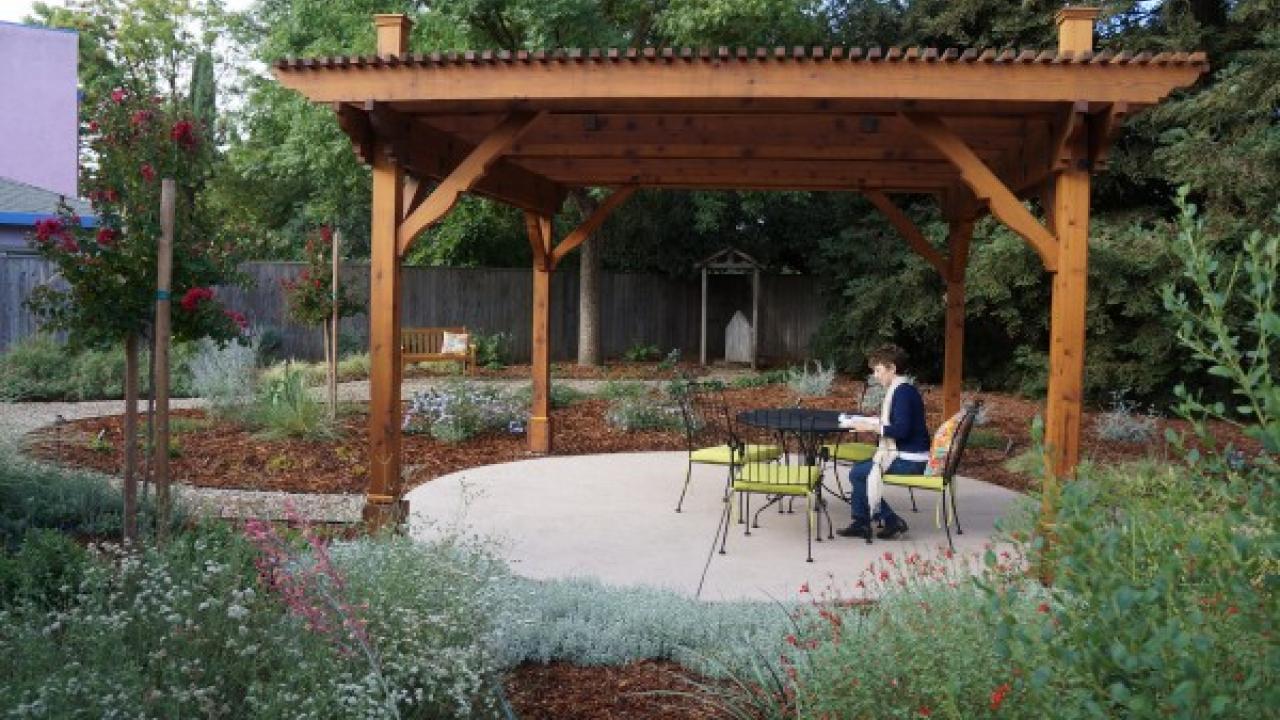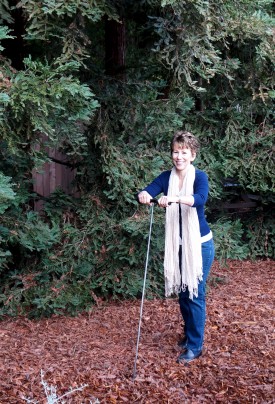
LIFE AFTER LAWN: A Davis Backyard Transformation
Look around your neighborhoods and it’s easy to see the toll four plus years of drought has taken on our outdoor spaces. When it came to cutting back our water use we eliminated the top consumer, our lawn-focused landscapes, but now what? Are “gold” lawns the new normal? Facing those same questions a year ago, Ria de Grassi, longtime Davis resident, removed her backyard lawn and hopes sharing her experience can help others who struggled, like her, with where to begin.
“I’m a single homeowner who works full-time and likes to travel,” says de Grassi. “I knew I couldn’t start this project without help, but I also knew the first thing any contractor would ask is what I was looking for in my life without a lawn. For me, the first step was to figure out what I liked. I did that by taking advantage of the free resources right outside my door.”
As a dyed-in-the-wool Aggie fan, alumna, and Friend of the UC Davis Arboretum and Public Garden, de Grassi got to know the plants she liked by walking the Arboretum, taking photos, and attending the free tours and talks they offer seasonally.
“Ever since my early days as a student, the Arboretum was my favorite place on campus,” recalls de Grassi. “So when I found out that Sequoia-level members of their support group are eligible for home consults, I jumped on the opportunity.

A diverse mix of native wildlife enjoys the new landscape in de Grassi’s backyard. Here a hummingbird feeds on autumn sage, Salvia x jamensis ‘Hot Lips’.
“Ellen Zagory, their director of public horticulture came to my yard, got a sense of my personality, my lifestyle, what plants I liked and didn’t like,” explains de Grassi. “She then put together a list of what she thought would do well in my space given the variety of exposures, and told me which plants perform well next to one another. I never would have been able to do that on my own.”
Once de Grassi had a better idea of what she wanted, she hired a local landscape contractor. A good place to start this process is the California Landscape Contractors Association website which offers in-depth search functions for finding the right company. Many contractors will provide free estimates.
“They tore out just about everything except my mature trees, and created what I call my outdoor Zen space,” explains de Grassi. “My yard is now filled with low-water plants I love that also provide forage for more wildlife than I’ve ever had before.”
As an agricultural issues and policy analyst for the non-profit California Farm Bureau, de Grassi is well acquainted with the importance of providing a safe haven for bees so the majority of what de Grassi planted are selections of UC Davis Arboretum All-Stars—tough, reliable plants that have been tested in the Arboretum, don’t need a lot of water, and support native bird and insects.
“It’s true what they say … plant it and they will come. My yard is abuzz with activity from hummingbirds, bees, dragonflies, and today I saw a lizard in my yard for the very first time,” says de Grassi. “It’s not just the animals that are thriving either. Last fall the plants looked so small. I thought it would be years before I could see the tapestry of colors and textures coming together; it’s better than I imagined it’d be just one year later. Fall really is the best time to plant.
The transition to life without a lawn has been a learning experience for de Grassi, especially when it comes to managing her new sub-surface irrigation. This highly efficient system self-adjusts its watering cycle depending on readings it receives from a remote weather station mounted on her fence.
“I still need to make irrigation adjustments here and there, but my plants like it and so does my water bill,” explains de Grassi. “Even though I am using more water to establish my new plants than I will in a year or two, it’s still less than it would be if it were lawn, and it’s only going to get better.”

The mature trees in de Grassi’s backyard are on a separate valve linked to an above-ground drip irrigation system covered in mulch. To determine whether or not the trees need water de Grassi uses a soil probe.
The other thing that has changed is how de Grassi waters her trees. Because mature trees were incorporated into her new landscape, the drip irrigation system for them is above ground – covered with mulch – with its own valve. The rest of her landscape has a sub-surface drip irrigation system with multiple valves.
“Now I deep water my trees about once a month,” says de Grassi. “I use a soil probe to measure whether or not they need water. I push it into the ground to about 18 inches … if the probe is muddy all the way to the 18 inch mark, I know I can wait to water; if the mud doesn’t reach the mark, then it’s time to water. It’s kind of like testing whether or not your cake is ready to come out of the oven!”
What is next for de Grassi? Her front yard! She’s applied for and been pre-approved to receive a rebate from the State of California’s lawn removal program and this week not only is that lawn coming out, she is visiting the Friends of the UC Davis Arboretum and Public Garden plant sale this Saturday to stock up. They’re celebrating 10 years of Arboretum All-Stars and will have their largest inventory to date of low-water, regionally-appropriate plants including California natives and Arboretum All-Stars, of course.
To learn more about de Grassi’s life after lawn, see photos, learn more about her plant selections, and other sales, visit the UC Davis Arboretum’s website at http://www.arboretum.ucdavis.edu.
Learn more about upcoming Friends of the UC Davis Arboretum and Public Garden PLANT SALES
SEE A PHOTO GALLERY OF de Grassi’s backyard transformation
A partial list of the plants in Ria’s backyard
- Aster x frikartii ‘Monch’ – aster monk
- Hydrangea quercifolia – oak leaved hydrangea
- Bouteloua gracilis – blue grama grass
- Epilobium canum – California fuchsia
- Erigeron karvinskianus – Santa Barbara daisy
- Heuchera ‘Rosada’ – rosada coral bells
- Muhlenbergia rigens – deergrass
- Nepeta x faassenii – hybrid catmint
- Origanum vulgare ‘Betty Rollins’ – dwarf oregano
- Solidago californica ‘Cascade Creek’ – Cascade Creek California goldenrod
- Cerastium tomentosum – snow-in-summer
- Ceanothus x pallidus ‘Marie Simon’ – Marie Simon ceanothus
- Hesperaloe parviflora – coral yucca
- Lavandula x ginginsii ‘Goodwin Creek Grey’ – Goodwin Creek lavender
- Salvia greggii and Salvia x jamensis – autumn sage
- Teucrium fruticans – bush germander
- Callistemon ‘Little John’ – Dwarf Callistemon
- Ceanothus ‘Ray Hartman’ – Ray Hartman ceanothus
- Eriogonum fasciculatum – California wild buckwheat
